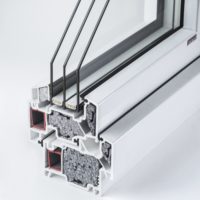Spacer for improvement

New legislation coming into force in 2022 will raise the bar on window energy performance. Careful specification, manufacture and installation of a window’s sealed unit is essential to comply, says John Cooper, commercial director at Swisspacer.
According to the Climate Change Committee, the built environment accounts for around 40% of the UK’s greenhouse emissions, with 14% of this coming from our homes.
It’s clear why new legislation is needed to improve residential energy efficiency and to keep the nation on track to meet the government’s 2050 net zero target.
First on the new legislative agenda is the uplift to Part L of the Building Regulations, which serve as a pre-cursor to the Future Homes Standard. The industry consultation on changes to Part L closed in April and the publication of the new regulations are due in December. By July 2022, it will become law for new and replacement windows.
While the exact detail of the regulations are not yet known, they’re likely to include an uplift in the minimum efficiency of new windows in existing dwellings from 1.6W/m2K to 1.4W/m2K, which is a significant step up from a minimum Band C to a Band B rating.

The changes are a stepping-stone to the Future Homes Standard, which will raise the bar even higher. Designed to complement Building Regulations, this more rigorous standard will produce 75%-80% less carbon emissions than homes being built under current regulations. All new homes will have to comply to the new standard from 2025.
But fabricating and installing energy efficient windows is about more than ticking boxes and ensuring compliance. By making homes more energy efficient, we are cutting customers’ energy bills and giving them homes that are more comfortable to live and work in too. We are also reducing the risk of condensation, which can lead to unsightly mould and mildew spores that are a health risk to those with breathing problems.
The challenge to improve energy efficiency in windows is based on making a series of smaller improvements that aggregate to a bigger improvement in performance. This includes improvements to multi-chamber profiles or high-performance thermal breaks. Here, we look specifically at how sealed units can boost green performance.
Sealed units help with insulation and reduce heat transfer, so it’s important they work at their best. If they are fogging, or there is damage to the glass or seal, they will let in air and/or moisture and the unit becomes ineffective at keeping the heat in and the cold out.
To protect the integrity of the sealed units, they must be specified with high performing components, right down to the spacer bar.
The Passivhaus Institute in Darmstadt conducted independent research which showed that using a warm edge spacer bar instead of aluminium in a triple glazed window can save homeowners an average of 8.6% on energy bills in cool/moderate climates such as the UK and Ireland. That’s the equivalent of 180kg less CO2 per household per year. Small change, big impact.
What should fabricators be looking for in a spacer bar?
An impermeable seal, which is proven to stop gas and moisture getting through should be first on the list, followed by a 100% impermeable long-life backing foil. Together, these features can prevent sealed unit failure, while keeping customers happy with their windows for longer.
To ensure the warm edge spacer bar delivers its green potential, it must be correctly installed in the sealed unit. This means using the correct amount of desiccant and a good quality sealant. When made and fitted to manufacturer-approved standards, a spacer bar will protect the integrity and performance of a window and save energy for many years to come.
Using a warm edge spacer bar comes with a slightly higher manufacturing cost, and fabricators and installers could be put off by the extra money involved. However, Passivhaus Trust research shows that the positive impact of warm edge technology on improved energy performance and reduced energy bills far outweighs the cost.
Swisspacer Ultimate was the first warm edge spacer bar to gain Passivhaus accreditation, and it sets the standard. Passivhaus’s database of certified components lists Swisspacer in 77% of windows, 80% of sliding doors and 92% of curtain wall systems. Every Swisspacer spacer bar has a 100% impermeable gas-tight barrier to gas and moisture. This means well-made sealed units with Swisspacer spacer bars at the heart continue to save money and energy for years.